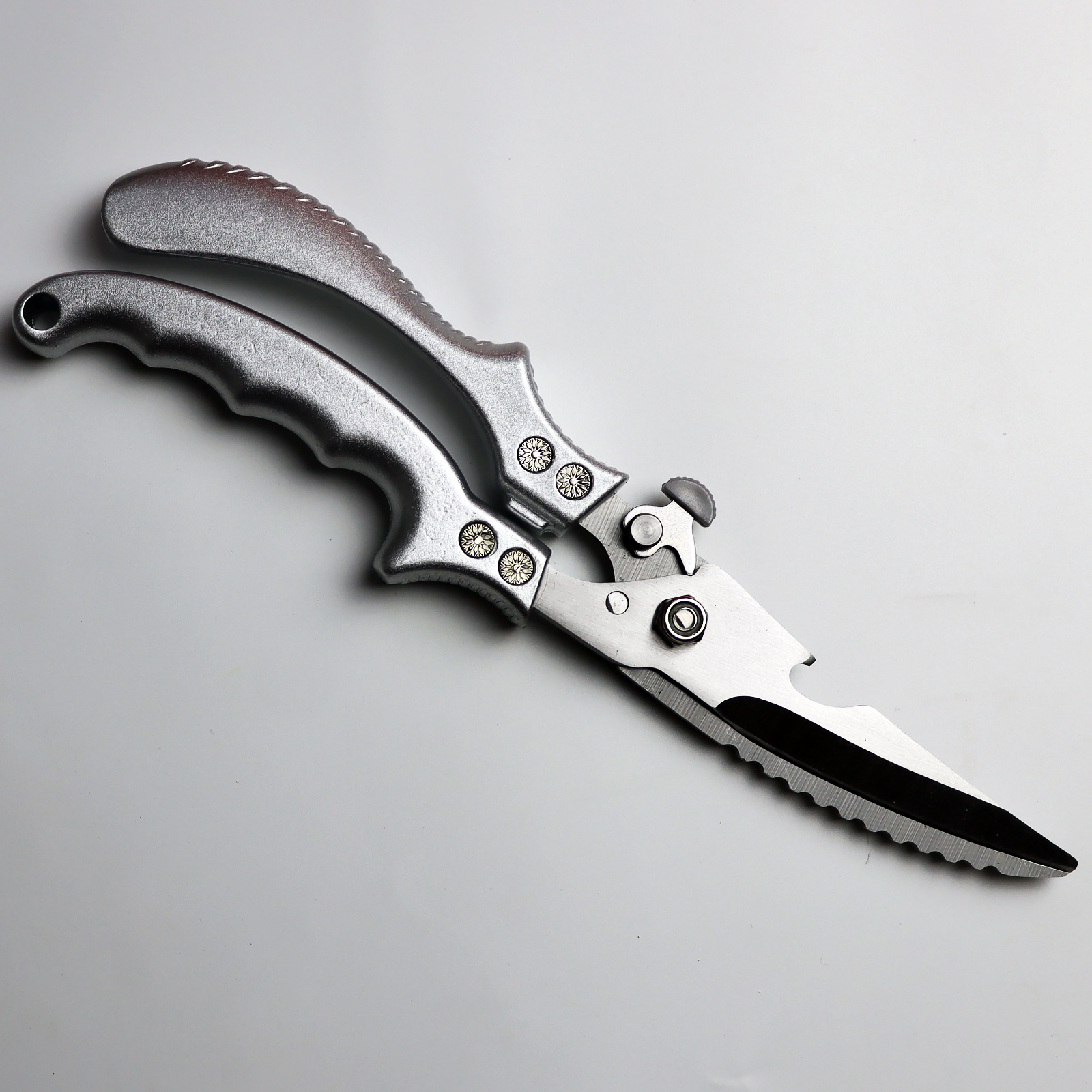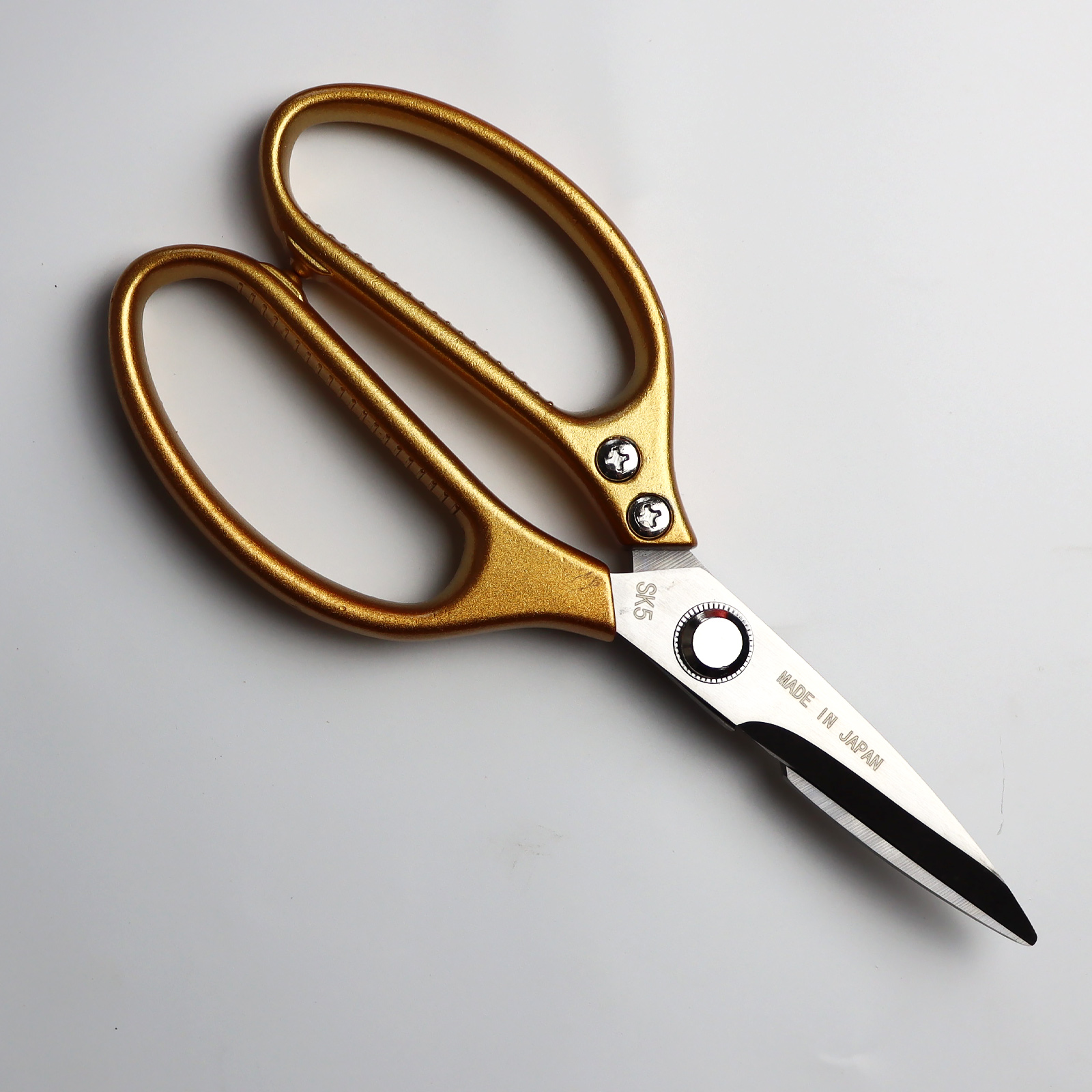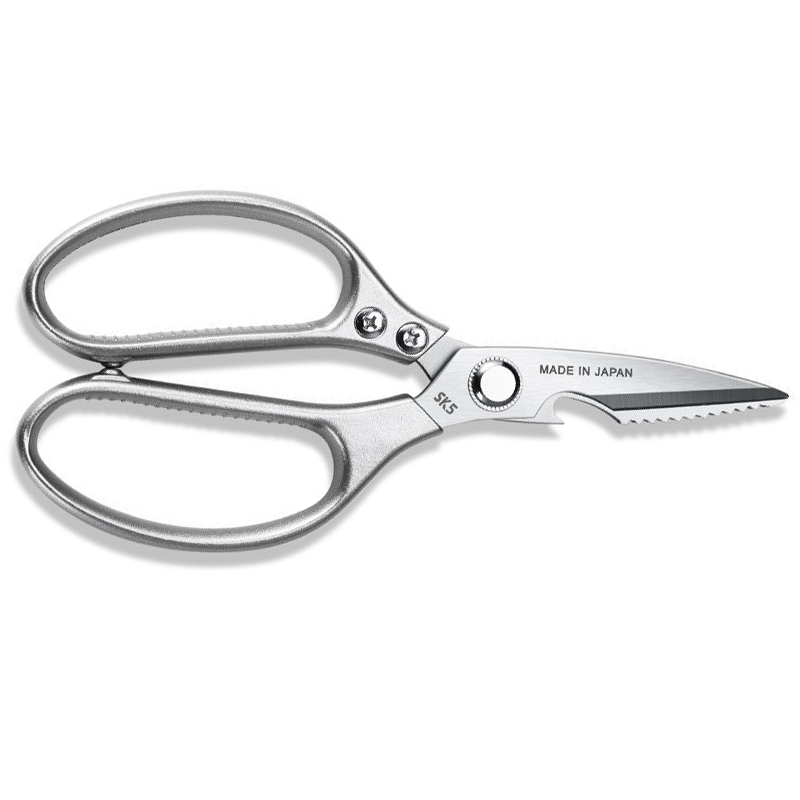Kitchen shears are a kitchen tool designed to cut through a variety of food products such as poultry, herbs, vegetables, and even packaging materials such as plastic or butcher string. They are essentially heavy-duty scissors designed for kitchen tasks.
Kitchen shears typically consist of two sharp blades connected by a pivot point, allowing them to cut through a wide range of ingredients with precision and ease.
What are Kitchen Shears Made of?
Kitchen scissors are typically made of stainless steel. Stainless steel is the preferred choice for kitchen shears because it is durable, rust-proof, corrosion-resistant, and easy to clean. The use of stainless steel ensures that the scissors stay sharp over time, making them suitable for cutting a variety of foods and materials in the kitchen.
- Durability: Stainless steel blades are strong and resistant to bending or breaking, making them suitable for cutting tough foods and materials.
- Corrosion Resistance: Stainless steel is highly resistant to rust and corrosion, even when exposed to moist or acidic foods. This ensures that the blade remains in good condition over time.
- Sharpness Retention: Stainless steel blades hold a sharp edge well, allowing for precise, efficient cuts with minimal effort.
- Easy to Clean: Stainless steel is non-porous and smooth, making it easy to remove food residue and maintain hygiene.
In addition to stainless steel blades, the handles of kitchen shears can be made of different materials, such as plastic, rubber, or silicone. These materials are chosen for their durability, comfort, and non-slip grip, providing users with a secure hold when using the scissors. Kitchen shears often feature ergonomic handle designs to reduce hand fatigue during prolonged use.
- Plastic: Plastic handles are lightweight, durable, and often come in a variety of colors. They are easy to clean and moisture-resistant, making them suitable for use in the kitchen. Additionally, textured or ergonomic designs can be incorporated into plastic handles for a more comfortable and secure grip.
- Rubber or Silicone: Rubber or silicone handles provide a soft, non-slip grip for comfortable holding even when wet. These materials have excellent heat resistance and are safe to handle when cutting hot food. They are also dishwasher safe and easy to maintain.
- Composite Materials: Some kitchen shears have handles made from a combination of materials, such as plastic with rubber inserts or stainless steel with silicone handles. These composite materials offer the benefits of durability and comfort, providing users with a balanced and secure grip.
What are Kitchen Shears Used for?
Kitchen shears are versatile tools that serve important purposes in food preparation and cooking. Here are some common tasks for using kitchen shears:
1. Cutting Poultry: Kitchen shears are ideal for cutting poultry, including chicken, turkey, and duck. They can easily remove excess fat, skin, and separate poultry into individual pieces.
2. Trimming Herbs: Kitchen shears are great for snipping and chopping fresh herbs like parsley, basil, cilantro, and chives. Their sharp blades allow for precise cuts, perfect for garnishing dishes or adding flavor to recipes.
3. Slicing Pizza: Instead of using a traditional pizza cutter, you can slice pizza directly on the pan or cutting board using kitchen shears. Their sharp blades provide clean, straight cuts through crusts and toppings.
4. Trimming Vegetables: Kitchen shears can be used to trim and cut vegetables such as green beans, asparagus, and broccoli. They can also julienne or chop vegetables for use in salads, soups, and stir-fries.
5. Cutting Pasta: When cooking pasta, you can use kitchen shears to trim the ends of spaghetti or lasagna noodles to fit in the pot. They can also cut cooked pasta into smaller, more manageable pieces.
6. Cracking Open Shellfish: For seafood lovers, kitchen shears can crack open crab legs, lobster claws, and shrimp shells. Their sturdy blades can handle tough shells, making it easier to access the delicious meat inside.
7. Cutting Fresh Produce: Kitchen shears make it easy to cut fruits like grapes and strawberries into small pieces for salads, snacks, or garnishes. They can also trim the stems of strawberries or the husks of tomatoes.
8. Trimming Baked Goods: When baking, kitchen shears can trim excess dough from pastry edges, cut shapes from rolled-out dough, or create decorative patterns in pie crusts.
9. Unpacking: Kitchen shears make it easy to cut through various types of food packaging, such as plastic bags, cardboard boxes, and vacuum-seal bags. They provide a quick and efficient way to access ingredients without the need for knives or scissors.
10. Tackling Miscellaneous Tasks: Kitchen shears can be used for a variety of other tasks, such as cutting twine, trimming parchment paper, snipping dried fruit or herbs, and even opening bottles or jars with the built-in bottle opener.
How to Sharpen Kitchen Shears?
Sharpening your kitchen shears is essential to maintaining their cutting performance and extending their lifespan. Here's a step-by-step guide on how to sharpen kitchen scissors:
Materials Needed:
- Sharpening stone or sharpening rod
- Lubricating oil (optional)
- Clean cloth or paper towel
Steps:
1. Disassembly (if possible)
Some kitchen shears have blades that come apart, making them easier to sharpen. If your shears are removable, carefully remove the blade from the handle.
2. Check the blade
Before sharpening, inspect the blade for any nicks, dents, or damage. If the damage is severe, consult a professional to repair or replace it.
3. Prepare the whetstone
If using a whetstone, moisten the stone with water or lubricating oil according to the manufacturer's instructions. This helps lubricate the surface and promotes effective sharpening.
4. Sharpen the blade
Hold one blade of the shears firmly against the whetstone at an angle of 20 to 30 degrees. Ensure the entire cutting edge is in contact with the stone.
Using gentle pressure, sweep the blade along the stone, starting at the base and working toward the tip. Repeat several times, keeping the angle consistent.
Turn the shears over and repeat the sharpening process on the other blade.
5. Test sharpness
After sharpening, carefully reassemble the shears (if disassembled) and test the sharpness by cutting a piece of paper or thin cardboard. The blade should cut smoothly and cleanly without binding.
6. Fine-tune if necessary
If the blade is not as sharp as expected, repeat the sharpening process. Use light pressure and maintain a consistent angle to avoid over-sharpening.
7. Cleaning and Lubrication
Once you're satisfied with the sharpness, clean the blade with a damp cloth or paper towel to remove any metal particles or residue. Alternatively, add a few drops of lubricating oil to prevent the blade from rusting.
8. Regular maintenance
To keep your blades sharp, sharpen them regularly with a sharpening stone as you do with your knives. This helps realign the blade edge and extends the time between sharpenings.
By following the steps above, you can effectively sharpen your kitchen shears and keep them performing at their best. Remember to be careful and maintain a consistent angle to avoid damaging the blade. If you're unsure about sharpening your shears yourself, consider seeking help from a professional sharpener.
What is the Difference Between Kitchen Shears and Scissors?
The main difference between kitchen shears and scissors is their design, construction, and intended use.
1. Design
Kitchen Shears: Kitchen shears typically have longer, thicker blades than regular scissors. They often have serrated or notched blades to provide better grip and cutting power, especially for tough foods like poultry or small bones. Kitchen shears may also have other functions, such as bottle openers or nutcrackers.
Scissors: Scissors usually have shorter, thinner, straight-edged blades. They are designed for general cutting tasks such as paper, fabric, or thread. Scissors may come in various sizes and designs for specific applications such as crafting, sewing, or office work.
2. Construction
Kitchen Shears: Kitchen shears are made of materials suitable for the kitchen environment. They usually have blades made of stainless steel for durability and corrosion resistance. Handles can be ergonomically designed and made from materials such as plastic, rubber, or silicone for a comfortable grip.
Scissors: The blades of scissors can be made of stainless steel, carbon steel, or other materials, depending on the intended use. The material and design of the handles can also vary, with some having finger loops for precise control while others have ergonomic handles for comfort during prolonged use.
3. Intended Use
Kitchen Shears: Kitchen shears are designed for food-related tasks such as cutting poultry, trimming herbs, slicing pizza, or opening food packages. They are common multi-purpose tools in the kitchen and are not typically used for non-food related tasks.
Scissors: Scissors have a wide range of applications besides the kitchen. They are used for cutting paper, cardboard, fabric, plastic, and other materials in a variety of environments such as crafting, sewing, office work, and household chores.
In summary, while kitchen shears and scissors are both cutting tools with blades and handles, they are designed and constructed differently to suit different uses. Kitchen shears are tailored for food-related tasks in the kitchen, while scissors are more general tools used for a variety of cutting applications outside the kitchen.
Fzkaly kitchen shears are designed for specific tasks, combining quality construction, versatility, efficiency, and additional features. They offer a reliable and convenient tool for various kitchen tasks, providing users with greater efficiency and precision in the kitchen.





